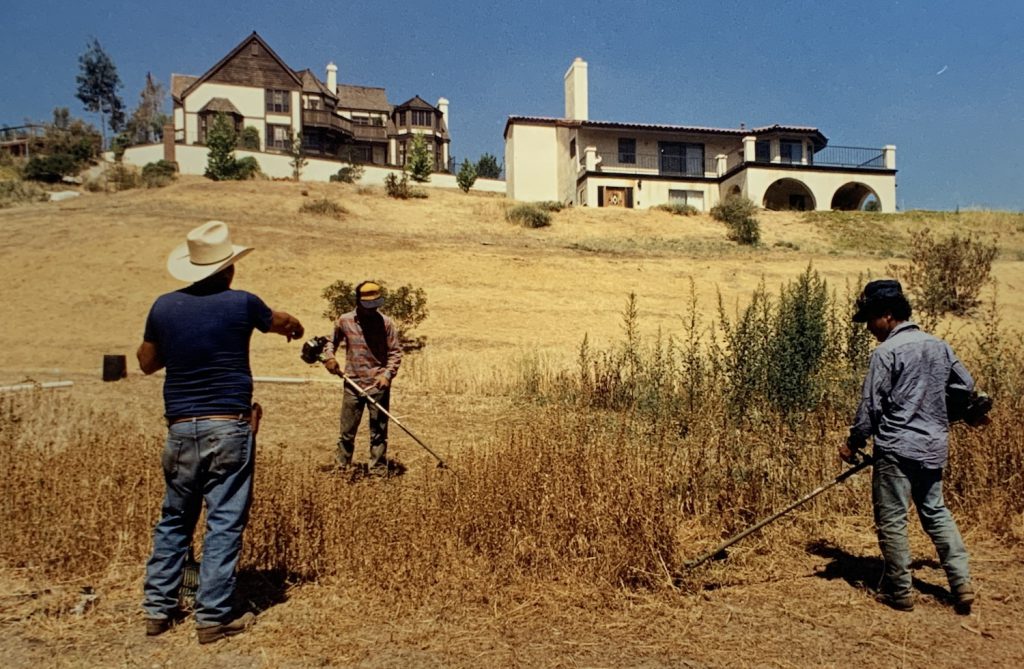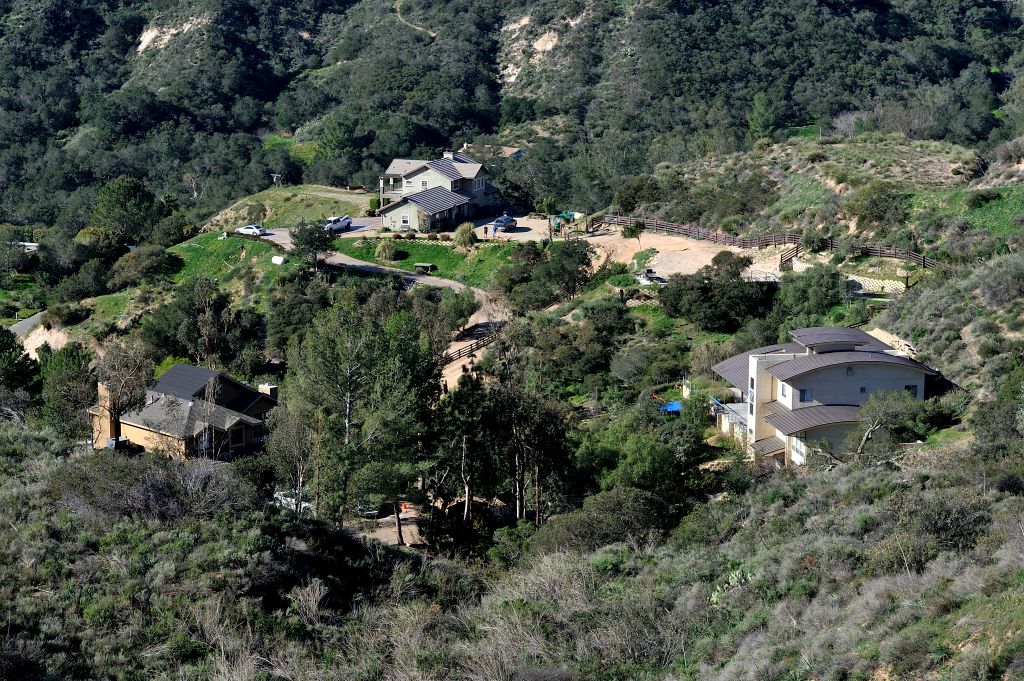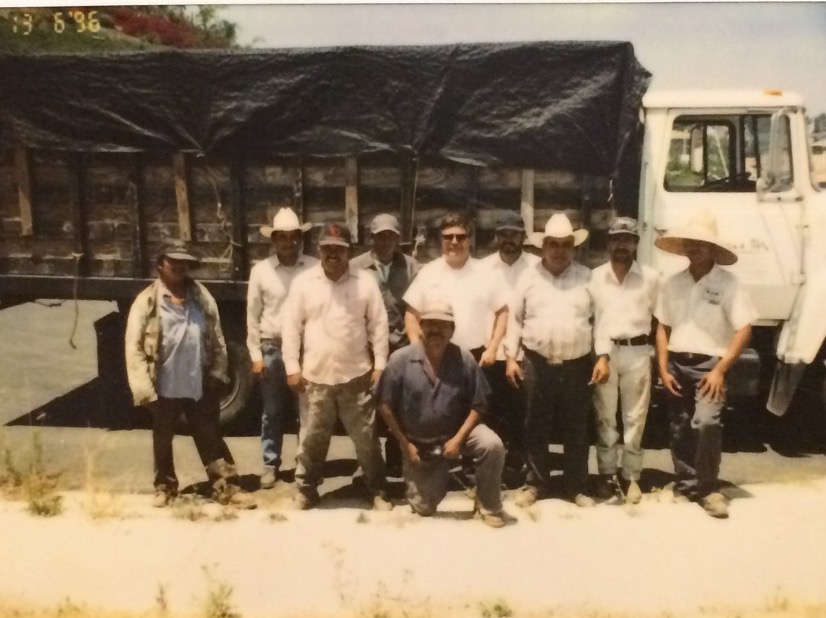These Unheralded Workers Are Helping Prevent the Next Wildfire

A few months after the wildfire season ended last fall in Southern California, I walked the charred remains of chaparral brush at the foot of an “exclusive rural community” in Orange County. Tucked into the Santa Ana mountains, the wealthy rural community of a couple thousand inhabitants is surrounded by old-growth oak, sycamore, and juniper trees that line two-lane roads crowded in by stout shrubs and dense grasses.
Sam (a pseudonym), a county official in charge of managing wildfire danger in rural and unincorporated areas such as this one, guided me through a cement V-ditch at the bottom of a canyon. Experts refer to these areas, where residential neighborhoods bump up against semi-natural areas, as the “wildland-urban interface” (WUI). To make our way across the ditch, we minded the uneven terrain and pushed overgrown patches of mustard grass and buckwheat out of our way.
Our goal was to glimpse some of the fire damage that had resulted from the recent Silverado Canyon fire and threatened nearby structures. Just above the canyon slope, a horse trail butted up against the backyard property line of what appeared to be a multimillion-dollar home. We paused as the first signs of the recent fire came into view in the distance: curled blackened branches and gray patches of earth.
Sam, pointing to the proximity of the home to the fire, dryly noted: “As you can see, we really don’t have many options here. We have to come in with crews during the spring to thin all this out.”
“What will happen if a place like this doesn’t get cleared out by weed abatement crews?” I asked.
“It’ll prove disastrous in the late summer and fall when the Santa Anas arrive,” Sam responded. “All this mustard will become tinder.”
Every year, the Santa Ana winds bear down on Southern California like clockwork and bring with them gusts of up to 70 miles per hour. High-wind advisories are put into effect, and fire watch warnings are given to the county’s foothill areas. Wind-driven fires can travel fast and far in any region—even as much as the length of a football field per second, as happened in the Camp Fire in Northern California. Coupled with dry conditions resulting from expanding regional drought caused by climate change, these volatile winds are the animating force behind wildfires in this part of the U.S.
Or as Sam put it, “If the chaparral and the non-natives [plants] can be thought of as the arteries of wildfire, giving them the fuel and terrain to spread, then the winds are its pumping heart—its engine.”
But I already knew all of that.
I grew up working in Orange County’s canyons and foothills alongside my late father, Juan Zárate, and his crew of Latino migrant weed abatement workers. The Santa Ana winds organized the economic and social life of my family for over three decades.
Now the winds and chaparral organize my research. As an anthropologist at the University of California, Irvine, I’m collecting ethnographic data to inform the future of county wildfire policy by talking with county officials, homeowners, independent weed abatement crews, and those that work for the Orange County Weed Abatement Program (OCWAP), the very program for which I worked every spring growing up and until my early 30s.
In fire-prone areas in densely forested parts of the western United States, authorities and landowners can sometimes rely on other methods, such as prescribed burns, to lessen the threat of wildfires. But in Orange County and other coastal parts of Southern California, these methods don’t always work.
Read on, from the archives: “Arizona’s Inmate Firefighters.”
The expansion of WUI private development in the region since the 1980s has meant that manual weed abatement efforts have become increasingly important, particularly because of the abundance of low-to-the-ground oily shrubs and grasses in this populated area. Only workers can maneuver deep in the canyons and close to property lines to eliminate fire threat.
For about four weeks in the spring, these small weed abatement crews scale the hills, canyons, and slopes of Orange County, jumping from one overgrown parcel of property to the next. They expertly thin out the biological fuel, both the non-native and highly flammable buckwheat, pampas, and mustard grasses, and the dried growth of the native chaparral biome.
Why, some readers might be wondering, have they never heard of weed abatement crews?
In sharp contrast to the familiar images of firefighters and aerial displays of water and Phos-Chek fire retardant being dumped onto the hills just feet away from canyon estates, weed abatement workers’ labor happens months before the broader society is reminded, viscerally, of Southern California’s flammable geography.
To appreciate the work of migrant workers as first first responders, we must attune our attention not to the fire season, a term that has entered into the mainstream, but to this earlier weed abatement season. That means recognizing the fact that life in the canyons means living intimately with fire year-round for the foreseeable future.
It also means reckoning with the unequal distribution of risk: In Orange County, while the most affluent communities tend to be the ones nestled in the WUI and at most risk of fire, they depend heavily on the ecological and technological knowledge of predominantly working poor Latino migrant weed abatement workers to keep them safe. As these risks grow with the impacts of climate change, so do the social and economic disparities between the communities who are protected and those who do the protecting.
Despite the crucial work that weed abatement workers do, I’ve learned that wildfire management experts have so far failed to appreciate the deep ecological knowledge and keen observation of these workers, who have long had a pulse on the shifting climate and wildfire threats from the ground level. My project aims to change that by putting the knowledge of weed abatement workers front and center.
What does it mean to live with wildfire? How about to make life from it?
While wildfires have always been endemic to California, they are returning with greater abandon every year, with a frequency, scale, and intensity that has never been experienced in recorded history. Last year, over 30 people died, and 4 million acres burned. The Golden State declared a state of emergency and had to depend on federal aid to combat the widespread conflagrations.
Yet, for me, the Santa Ana winds, despite being harbingers of mass evacuations and fire devastation, have long meant something entirely different: life. Growing up as part of a working poor migrant family whose livelihood was made from managing fire risk for the county’s rural and unincorporated communities, the winds meant survival.
Every spring, months before the Santa Ana winds would show up across the southland, my father would put together his crew of weed abatement workers. Hailing primarily from the Mexican states of Jalisco, Michoacán, and Nayarit, they all had extensive horticultural knowledge, having worked as farmworkers and/or landscapers in the U.S. prior to their weed abatement work. Some were family friends and relatives, and many were undocumented.
What does it mean to live with wildfire? How about to make life from it?
Just feet from the property lines of some of the county’s wealthiest estates and beautiful nature reserves, my father and members of his crew would come in and clear brush to create firebreaks, areas with ample space where firefighters can hold their last line of defense in the case of a wildfire event.
Creating these breaks isn’t easy; workers must draw on their environmental knowledge and highly skilled techniques involving shovels, weed whackers, and machetes. While scaling canyon walls, they must distinguish between weeds and native chaparral, and judge, on the fly, the vitality of native plants and whether they are to be thinned or removed from the hillside. This horticultural knowledge can tip the scales between protecting native ecologies for generations to come and protecting property during the fire season ahead.
When weed abatement workers are done clearing a property, what is left behind is, well, nothing.
The firebreaks, as the absence of overgrown weeds, create a picture of Orange County’s increasingly inhospitable canyons as fully under control. Yet, this work, as important as it is, can only go so far. The question on the minds of officials in charge of wildfire policy is: “Just how long can weed abatement stave off the effects of climate change?”
This is the question of my research too—though I think about it in terms of how we might turn the question to weed abatement workers themselves.
When I first started research into wildfire mitigation efforts a couple of years back, I visited the office of Jon Anderson, the director of OCWAP. The two of us looked through old files, newspaper clippings, and other ephemera from the program’s decades of existence, all meticulously kept in his office.
He purposely guided me to a drawer where I would stumble on a photo of my father and his weed abatement crew standing alongside Jon.
With a sense of playfulness, Jon asked, “Recognize anyone?”
The photo, taken in the early 1990s, memorialized my father’s purchase of a new dump truck that was capable of hauling away larger quantities of brush.
The photo elicited complex feelings for me as a researcher who grew up as an undocumented youth working on the very hills I now study—a feeling akin to seeing a family album in somebody else’s home.
As I held the picture in my hand, and looked at the old familiar faces, I thought about today’s migrant workers who continue to descend into the canyons for one month out of the year, and how they might one day end up in a photo tucked away in a county drawer.
In the months since that visit, I have continued thinking of that photo. As I play with it in my mind, I can’t help but think of it as a photo negative—an image that captures the unheralded work needed to stabilize and secure the splendor of the county’s affluent canyon estates. In the years to come, as climate change intensifies, everyone’s joint survival may depend on bringing this photo negative to the surface.
While my research is still ongoing, it’s leading toward a proposition that values weed abatement workers’ knowledge about ecology and wildfire, and relies on it to shape meaningful policy change across Southern California’s WUI. What if we consult with workers as scientific thinkers and doers in the battle against climate change? What kinds of expertise might their decadeslong observations and grounded knowledge of the winds and chaparral offer?
Unlike in the past, the way forward will require conferring with weed abatement workers as full collaborators and experts. My hope is that those living in the canyons also recognize how their lives are directly supported by the racialized work of weed abatement, often done by working poor Latino migrants. After all, as climate change brings about more risk for affluent homeowners, their lives will be brought closer to those whose work, though largely invisible until now, has kept them safe.



































